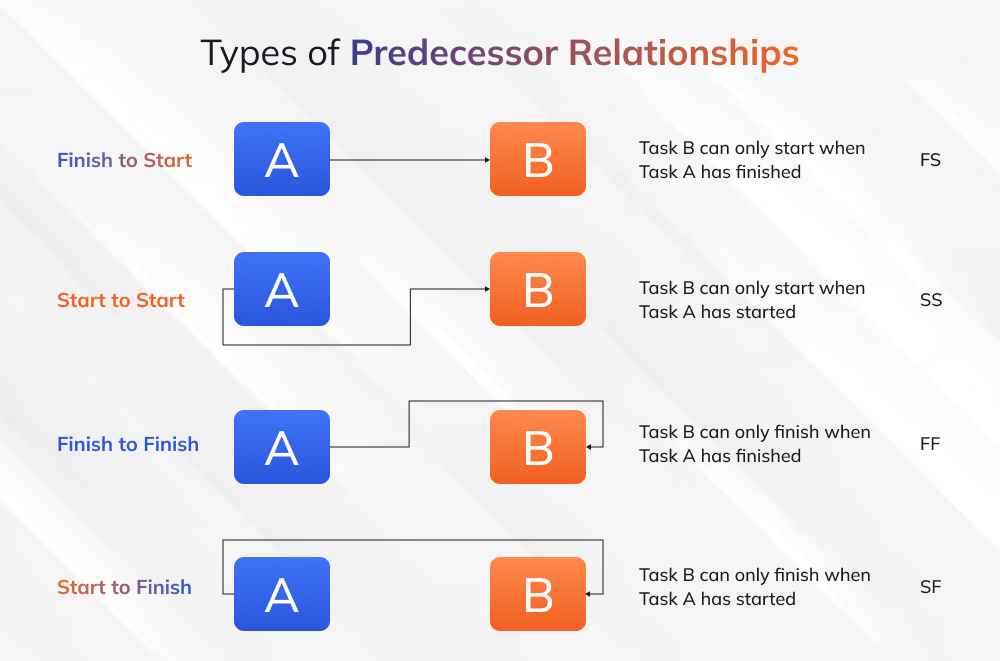
Every successful project follows a sequence of steps, and each step depends on the one that came before it. Without a clear order, teams face confusion, overlapping work, and costly delays. That’s where predecessors come in.
Predecessors define how tasks connect, making schedules realistic, balancing resources, and reducing risks. When used effectively, they transform a messy list of tasks into a clear, actionable roadmap that keeps everyone aligned.
Put simply, predecessors are the quiet organizers behind smooth projects. They may not grab attention, but without them, even the best plans can quickly unravel.
What Is a Predecessor in Project Management?
In project management, a predecessor is any task that must be completed before another can start. Think of it as the “building block” that determines how work flows from one activity to the next. By identifying predecessors, project managers create a logical sequence of tasks that keeps schedules realistic and resources well-balanced.
Why does this matter? Because projects often fail when sequencing is ignored. Only 34% of organizations mostly or always complete projects on time, highlighting the ongoing challenge of effective schedule management.
Properly mapping predecessors and project dependencies helps address this issue. The impact is evident when examining performance data. The average project performance rate is 73.8% globally, which means more than one-quarter of project objectives still fall short.
Predecessors play a direct role in enhancing this performance by mitigating conflicts and clarifying the workflow order.
In short, predecessors are not just technical terms in scheduling software; they are the foundation of smooth execution. They ensure that each task fits into the bigger picture and that the project can move forward without unnecessary setbacks.
The 4 Types of Predecessor Relationships
Predecessor relationships define how tasks connect in a project schedule. Without clear mapping, sequencing becomes guesswork and costly delays are more likely. Research shows that 42% of project managers do not follow defined methodologies, making their projects 15% less likely to meet goals and 16% less likely to finish on time or within budget. Dependencies provide the structure that reduces this risk.
Why Dependencies Matter
The industry still struggles with project failure, with a global project failure rate of 12%. Strong use of predecessor relationships helps lower that number by keeping task order transparent and enforceable. Studies also confirm that fully remote, hybrid, and in-person teams all show similar performance (about 73%) when they use visual dependency mapping. These insights prove that properly defined predecessors are essential to maintaining control, regardless of team setup or location.
Here are the four main predecessor relationships you’ll encounter:
- Finish-to-Start (FS): The most common type. Task B cannot begin until Task A finishes. Example: coding must finish before testing can begin.
- Start-to-Start (SS): Task B can start once Task A starts. Example: design and content creation in a campaign can progress in parallel.
- Finish-to-Finish (FF): Task B cannot finish until Task A finishes. Example: editing a document cannot finish until writing is complete.
- Start-to-Finish (SF): The rarest type. Task B cannot finish until Task A starts. Example: a night shift cannot end until the day shift begins.
By applying these relationships correctly, project managers create clarity, reduce rework, and build more reliable schedules.
Practical Application: How to Use Predecessors?
Knowing what predecessors are is only half the job. The real value comes from applying them to project schedules. When mapped correctly, predecessors help managers predict bottlenecks, avoid resource conflicts, and align tasks with decision-making timelines.
Decision-making speed is a major factor here. Studies show that if project sponsors make dependency-related decisions within 1 hour, the project success rate reaches 58%. But if those decisions take 5 hours, success rates fall to just 18%. In other words, delays in confirming task dependencies directly reduce project outcomes.
Practical steps to apply predecessors include:
- Define Task Order Early: List all tasks and determine what must finish before the next begins.
- Use Visualization Tools: Gantt charts and network diagrams make relationships easy to see and adjust.
- Review with Stakeholders: Confirm dependencies so that decisions and approvals don’t create delays.
- Monitor and Adjust: As projects evolve, check dependencies regularly and update them as needed.
By combining speed in decision-making with the right tools, teams can turn predecessors into a powerful driver of project success.
Best Practices for Effective Predecessor Management
Once predecessors are mapped, managing them effectively becomes critical to project success. This goes beyond linking tasks in project management software; it’s about aligning teams, communication, and proactive planning. Done well, it boosts project success rates; done poorly, it creates bottlenecks and confusion.
A key challenge is benefits realization. One reason only 36% of organizations fully realize project benefits is weak sequencing and dependency management. Even completed projects can miss their intended outcomes if predecessors aren’t mapped clearly.
Another critical factor is soft skills. Organizations that prioritize communication and interpersonal skills report 8% higher project success rates and 12% less scope creep. These skills are essential when explaining dependencies to stakeholders and re-evaluating them as conditions change.
Best Practices Checklist
|
Common Pitfalls to Avoid in Project Dependency Management
Many projects fail not because of resources or scope but due to mismanaged predecessors. Avoiding these pitfalls keeps schedules realistic and outcomes aligned:
- Overlooking hidden dependencies: Ignoring indirect task links leads to unexpected delays. For example, forgetting that design approval must happen before vendor onboarding.
- Relying only on software: Tools are essential, but without clear communication, dependencies can still break down. For example, when a Gantt chart is updated, but stakeholders never get notified.
- Failing to adapt: Projects evolve, and predecessors must remain flexible, not static. For example, adjusting a launch timeline when new compliance reviews are introduced.
In summary, the difference between project success and failure often lies in managing both the technical and human sides of predecessors. Addressing these pitfalls ensures smoother workflows, better resource allocation, and higher on-time completion rates.
Using Predecessors in Project Management Software
Modern projects are too complex to track dependencies manually. This is where project management software becomes essential. Tools like Microsoft Project, Asana, or Smart sheet allow managers to link tasks, set automatic updates, and visualize dependencies in Gantt charts or network diagrams.
The demand for such tools is only growing. The project management software market is projected to reach USD 15.08 billion by 2030, driven by organizations seeking better dependency tracking and workflow visualization.
Performance data reinforces this shift. Around 77% of high-performing projects use project management software to manage predecessors and successors.
Despite their importance, only 23% of organizations use project management software to visualize dependencies, like Gantt charts or network diagrams.
Capterra confirms that adoption is widespread across industries, from construction to IT. Companies rely on these tools not only for scheduling but also for collaboration and reporting.
Why Does It Matter?
- Automation reduces errors: When one task shifts, dependent tasks update automatically.
- Visualization aids clarity: Teams see the whole workflow instead of scattered tasks.
- Integration boosts collaboration: Dependencies stay aligned across hybrid or remote teams.
In short, software is no longer optional; it’s the backbone for mapping and managing predecessors in modern project environments.
Conclusion
Predecessors are the unseen connectors that hold a project schedule together. By defining task orders, they prevent confusion, delays, and wasted resources, while ensuring every activity aligns with the bigger picture. Understanding the four predecessor relationship types, applying them with visualization tools, and engaging stakeholders early turns sequencing into a strategic advantage. Strong predecessor management not only reduces project failure rates but also boosts collaboration, clarity, and benefits realization.
So, even if your team is remote, hybrid, or on-site, treating predecessors as a core part of planning will help you deliver projects on time, within budget, and with greater confidence.
Explore our Project Management courses to master advanced dependency mapping, stakeholder communication, and proven techniques for boosting project success.















